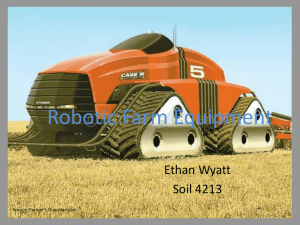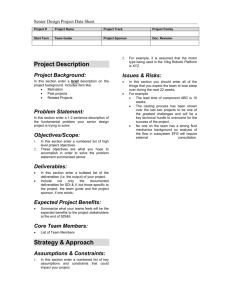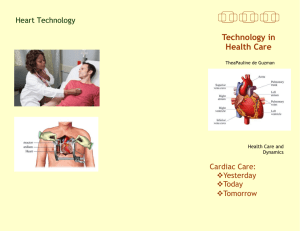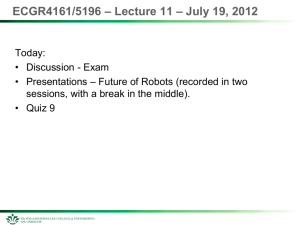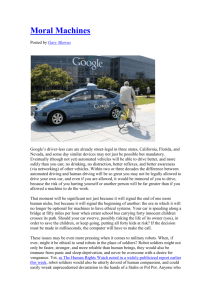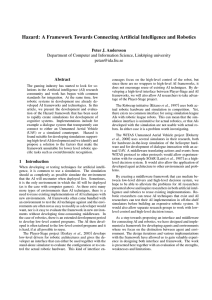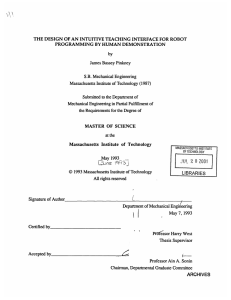Chapter 11c -- Applied Architecture and Styles -
advertisement
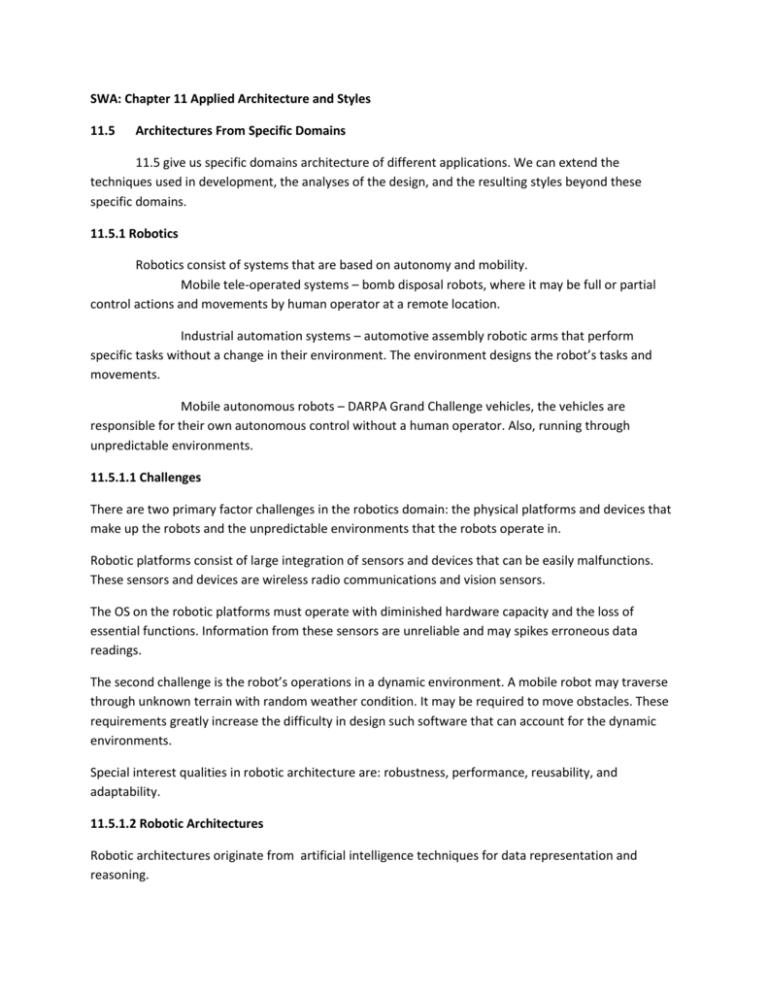
SWA: Chapter 11 Applied Architecture and Styles 11.5 Architectures From Specific Domains 11.5 give us specific domains architecture of different applications. We can extend the techniques used in development, the analyses of the design, and the resulting styles beyond these specific domains. 11.5.1 Robotics Robotics consist of systems that are based on autonomy and mobility. Mobile tele-operated systems – bomb disposal robots, where it may be full or partial control actions and movements by human operator at a remote location. Industrial automation systems – automotive assembly robotic arms that perform specific tasks without a change in their environment. The environment designs the robot’s tasks and movements. Mobile autonomous robots – DARPA Grand Challenge vehicles, the vehicles are responsible for their own autonomous control without a human operator. Also, running through unpredictable environments. 11.5.1.1 Challenges There are two primary factor challenges in the robotics domain: the physical platforms and devices that make up the robots and the unpredictable environments that the robots operate in. Robotic platforms consist of large integration of sensors and devices that can be easily malfunctions. These sensors and devices are wireless radio communications and vision sensors. The OS on the robotic platforms must operate with diminished hardware capacity and the loss of essential functions. Information from these sensors are unreliable and may spikes erroneous data readings. The second challenge is the robot’s operations in a dynamic environment. A mobile robot may traverse through unknown terrain with random weather condition. It may be required to move obstacles. These requirements greatly increase the difficulty in design such software that can account for the dynamic environments. Special interest qualities in robotic architecture are: robustness, performance, reusability, and adaptability. 11.5.1.2 Robotic Architectures Robotic architectures originate from artificial intelligence techniques for data representation and reasoning. SPA: Sense-Plan-Act Architecture from Nilsson in 1980, identifies the need of using a continuous feedback from the robot’s environment as an input to its actions. There are 3 components with a unidirection flow of communication between them: Sense, Plan, and Act ( Figure 11-9). The sense component gathers sensor information as inputs to the plan components. The plan component uses these inputs to create actions that the robot should perform. The act component is to communicate and execute using the robot’s motors and actuators. The SPA architecture resembles the sense-compute-control (SCC) pattern in Chapter 4. But an important distinction is in the plan component there is a world model that use the sensory inputs to determine the robot’s actual state and determine what actions should perform next. The internal model is constantly updated to be consistence with the actual environment conditions. The SCC pattern does not have such a model. The main drawback of SPA architecture is performance and scalability. Sensors information must be integrated or sensor fusion into the robot’s planning model to determine its actions in each iteration. These operations are time-consuming and cannot keep up with fast environmental changes. Subsumption: Subsumption attempted to address the drawback in SPA architecture by Brooks in 1986. Give up the complete world models and plans as the central element in robotic systems. There is no explicit planning step between sense and act. Subsumption architecture composed of independent components and each encapsulated with a specific behavior. Complex layers communicate through two operations: inhibition and suppression (Figure 11-10). “In the figure, output from Skill C may cause the input from Skill A to Skill B to be delayed by time t; similarly output from Skill C may override the output of Skill B to Actuator 1 for time t” Rather representing as a single plan model, subsumption architecture creates independent modules arranged in layers. It is more reactive in nature. Subsumption offers fast and nimble performance. Subsumption drawbacks are lacking a coherent architecture plan and no support for the complex layers. Three-Layer: Three-layer (3L) is a hybrid architecture that attempt to bridge the gap between SPA and subsumption by Firby in 1989. This architecture separates the robot functionality into three layers (name may differs from system to system Figure 11-11): reactive layer-react to events with a quick action sequencing layer-linking functionalities in the reactive layer into complex behaviors planning layer-performs slower long-term planning 3L combines both reactive operation and long-term planning. Many 3L architectures have special-purpose scripting language. One challenge with the 3L architectures is separate functions into three layers. Depending on the tasks, one layer may dominate the other layers in importance and complexity. The sequencing layer may results in difficulties when translating higher-level planning into lower-level execution and may cause unnecessary performance overhead. Reuse-Oriented With modern software and engineering technologies, the primary goals is component reuse to maximize returns on time and cost during development. Reuse-Oriented architectures consist of explicit object-oriented interface definitions for components and the use of frameworks for developing component that are reusable across different projects. The WITAS unmanned aerial vehicle project by Doherty et al in 2004 uses CORBA as information interchange and using CORBA IDL to clearly defined interfaces for each component. The CLARATy reusable robotic software architecture by Nesnas et al in 2006 is a two layer architecture that use a goal-network approach for planning. It defined a generic device interfaces so different devices of the same type can be use with any instance of CLARATy architecture. Development Framework for Robotic Systems Many robotic systems are designed and built independently. There are a number of frameworks and tools to speed up the development process. Each framework targets a specific aspect of robotic development. Popular Frameworks: Player-open-source project targets Unix-based environments. Provides networked accessible interfaces to many devices with support for distributed operations of robotic components. Supports integrations with the Stage and Gazebo 3D system. Orca-open-source, cross-platform framework focused on component-based robotic systems. It uses the Ice middleware framework for cross-component communication. Microsoft Robotic Studio-MRS is a free integrated environment for robotic system development. It supports .NET-based service-oriented architecture with C# and VB.NET languages. The environment simulation supported through PhysX simulation engine. Lego Mindstorms-provide both hardware and software. Low cost and easy application to educational needs. The package contains servos and sensors along with a special-purpose OS and LabVIEW graphic development environment by National Instruments. 11.5.2 Wireless Sensor Networks Senors nets are a large reactive application that monitor the environment and report on its state. Wireless sensor network (WSN) systems are used in various domain: medical systems, navigation, industrial automation, and civil engineering such as monitoring and tracking. These systems are low installation cost, inexpensive maintenance, and easy reconfiguration. But it is very challenging to implement: it may need to integrate with legacy wired networks, embedded devices, mobile networks with PDAs and cell phones for notifications. The wireless devices are constrained with power consumption, communication bandwidth and range, and processing capacity. Wireless sensor systems constraints are fault-tolerance, performance, availability, and scalability. MIDAS architecture contains 3 architecture styles (Figure 11-12): Peer-to-peer-deployment activities, exchange application level components Publish-subscribe-the communication backbone for routing and processing sensor data on various platforms Service-oriented-less used for system monitoring and adaption facilities. These services are distributed among the platforms. 11.6 End Matter The theme of this chapter was architectures for complex applications resulted from different application domain. Careful choices of elements and styles and a hybrid of these elements create a coherent solution. REST is an excellent example. REST coped with issues of presence latency and agency in network. Peer-to-peer highlighted area are discovery of other peers, search for resources, and risks of performance problems and malicious entities. Security and trust will be discuss in Chapter 13. Growing scope does not become more complex if we exploit ideas in large commercial applications such as Google, Akamai, and Skype. The next three chapter 12, 13, and 14 will address non-functional properties such as scale, performance, and security.

